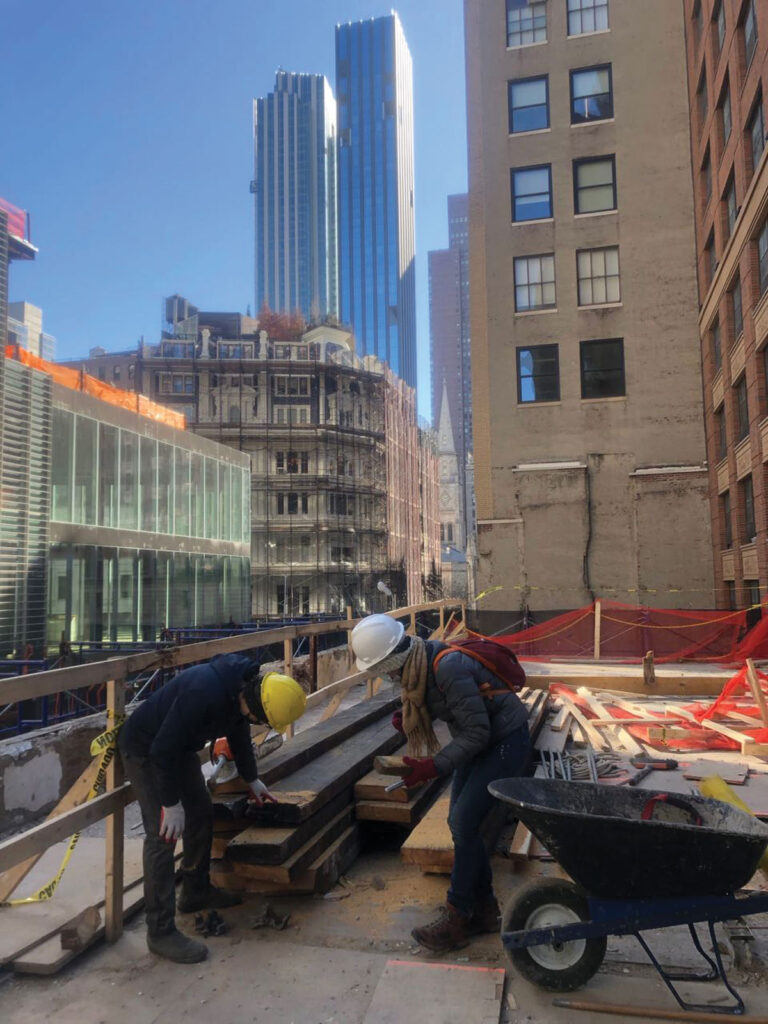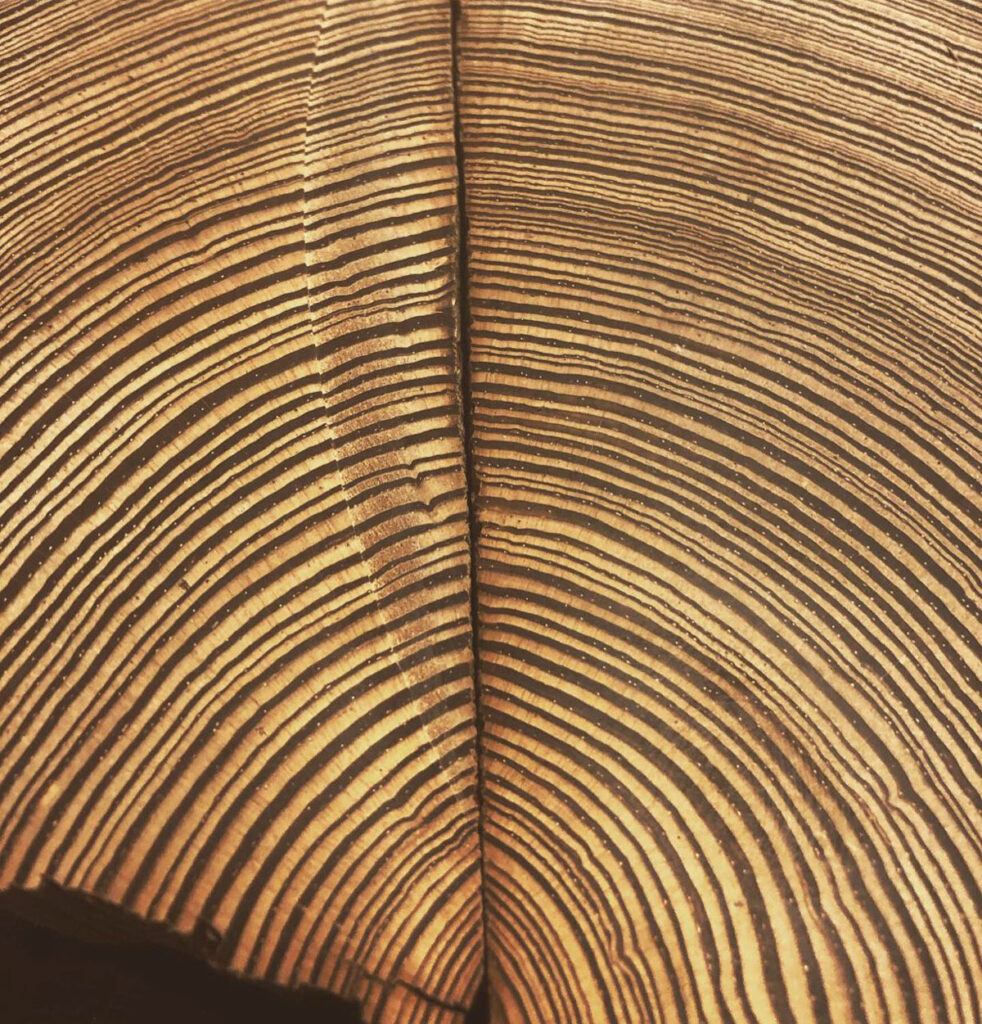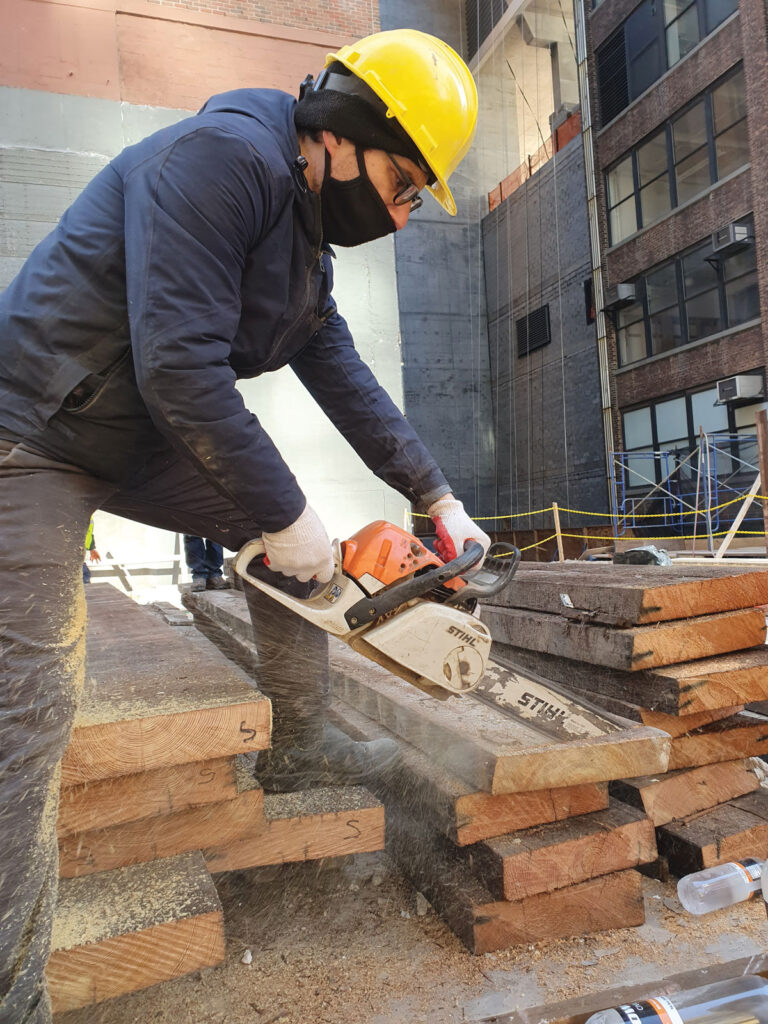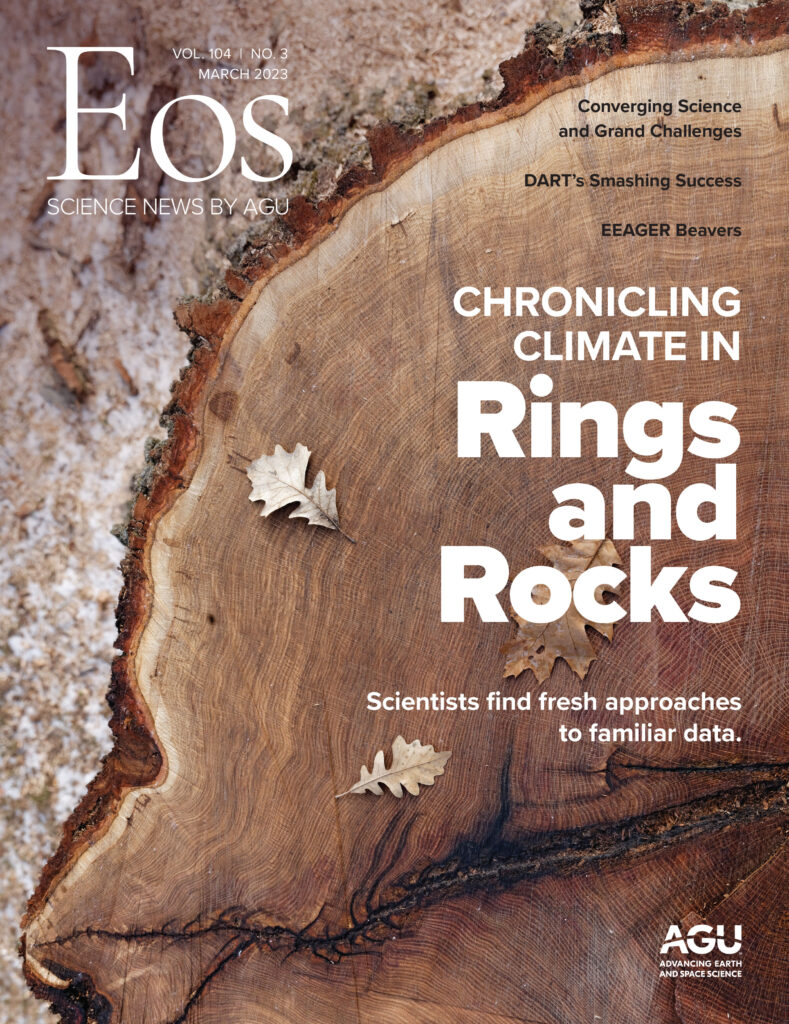Mukund Palat Rao prefers the quiet of a forest grove, but on a winter day in Lower Manhattan, the ecoclimatologist was surrounded by buzzing chainsaws just blocks from Wall Street. He was there to rescue a piece of New York’s heritage from a six-story residential building at 142 Fulton Street.
Hidden in wooden joists and beams in New York City’s oldest buildings is the largest repository of old-growth timber in the eastern United States, said Rao. These timbers can hold valuable information about past climates—but it can be uncovered only if scientists can get their hands on the timbers before they go to a landfill.
Scientists and engineers estimate that 14,000 cubic meters of old-growth wood are removed from buildings in New York City (NYC) each year during demolitions or renovations; the city is continuously being remade. Rao, a scientist at Lamont-Doherty Earth Observatory’s Tree Ring Lab at Columbia University, wants to ensure that the history locked in this valuable old growth isn’t lost.
The Advent of Tree Ring Science

Each spring, a tree begins growing a new ring. This early growth is light colored and often contains larger cells; the wood turns darker in the fall, and new cells are smaller. An entire ring includes both light and dark wood, and its thickness is an excellent marker of how wet the environment was during its year of growth. A skinny ring denotes a dry year; a thick ring indicates a wet year.
Dendrochronology emerged as a tool for studying past events in the late 1800s, when an astronomer, Andrew E. Douglass, recorded the patterns of wide and narrow rings on ponderosa pine stumps near the Lowell Observatory in Flagstaff, Ariz.
Since then, tree rings have become a popular proxy to estimate past meteorological conditions. Ice cores, speleothems, and even bat guano have all revealed Earth’s ancient and historical secrets, but tree rings are unique because trees are so widespread. Since Douglass’s first observations, scientists have measured tree rings in forests, violins, and shipwrecks. The International Tree-Ring Data Bank at NOAA has more than 5,000 tree ring measurements from six continents.
Scientific findings from tree rings can advance climate science and inform regional policies. In 2004, an influential paper in Science suggested that the U.S. Southwest was in the midst of a long-term drought on the basis of tree ring records from the West spanning 600 years. Today, knowledge of this 22-year-long “megadrought” has prompted the widespread adoption of sustainable water practices.
Records like these also shed light on how climate change alters the planet. Rings in trees from the British Isles and the Mediterranean suggest that the North Atlantic jet stream has become less stable since the 1960s.
Unfortunately, some of the United States’ longest tree ring records have been lost. “Because of the history of deforestation, it’s hard to find old-growth forests,” said Rao.

By the mid-20th century, logging had felled huge swaths of old-growth longleaf pine forests in the Southeast and eastern white pine forests in the Northeast—two of the most popular species of wood for building at the time. Longleaf pine forests once stretched for more than 36 million hectares (90 million acres) across the southern United States, but only 1.8 million hectares (about 4.5 million acres) still stand.
New York City’s rapid urbanization in the late 1800s stoked a hot market for timber. NYC has the third-highest number of skyscrapers of any city in the world (behind Hong Kong and Shenzhen, China), and 95% of its buildings are believed to have wood framing and materials.
Saving a Gilded Age Landmark
In 2019, dendrochronologist Ed Cook, who leads the Tree Ring Lab at the Lamont-Doherty Earth Observatory, was contacted by the new owners of the Terminal Warehouse in Chelsea, Manhattan. The owners were renovating the building into a hub of office space, restaurants, and shops. They recognized the value of its giant wooden joists and reached out to Cook to learn more about the timbers.
Taking up a whole city block, the Terminal Warehouse was a signature feature of the Chelsea neighborhood. It provided nearly 92,000 square meters (1 million square feet) of retail space and had offered some of the city’s only cold storage in its early days. Railroad tracks once ran straight into the building, and its pier sat on the Hudson River. In its more-than-a-century-long existence, the building housed Broadway sets, a nightclub, and untold numbers of goods such as furs, rugs, wines, liquors, and rubber.

No stranger to cold calls like this, Cook agreed that the Tree Ring Lab would study the warehouse’s timbers. He has studied such timbers in more than 150 structures in the eastern United States, including Philadelphia’s Independence Hall, as well as wood from an 18th-century shipwreck found under the World Trade Center.
Rao and another dendrochronologist at the Tree Ring Lab, Caroline Leland, took on the assignment.
A Search for the Timber’s Origins

In the summer of 2019, Rao and Leland went to the Terminal Warehouse, where the timber that had been removed from renovated sections of the building sat stacked under low-hung ceilings in the basement. They sawed off wood from 22 joists and cored wooden columns. Comparing these samples with tree samples from across the United States would reveal where they once grew, before New York City gobbled them up.
Leland and Rao noticed that some timbers still had sapwood, the soft outermost layers of a tree that separate the inner heartwood and the bark. This sapwood would help the two decipher precisely when the trees had been cut down.
Back at the lab, they identified the wood as longleaf pine. It had all the species’ telltale characteristics: substantial amounts of resin; high color contrast between the dark latewood and light earlywood in the tree rings; and a pencil-sized pith, or center of the tree.
Under a microscope, the scientists measured the width of each ring from pith to outer edge. Once they were done, they had a string of numbers from each sample—a “barcode” of the tree’s growth history.

Comparing these barcodes with others published by scientists from trees around the country, Leland and Rao found that the Terminal Warehouse timbers were likely chopped down in the late 1800s in western and central Georgia and eastern Alabama, where they’d probably grown on dry mountainous slopes. One timber from the Terminal Warehouse had rings from as early as 1512.
The team hypothesized that the 110-kilogram (250-pound) joists came from the Sample Lumber Company near Hollins, Ala., and likely traveled by rail to a port in Savannah, Ga., before making the final leg of the journey on a schooner up the Hudson. The group published its findings in the Journal of Archaeological Science: Reports, adding to the growing recognition of Southern pine trees as an essential foundation of NYC’s expansion during the Gilded Age.

Striking It Rich
New York City is a kind of national park of salvaged lumber.
The research would have stopped there without help from a Brooklyn wood salvager, Alan Solomon.
Solomon grew up at his father’s junkyard in Boston and now runs a wood salvaging company, Sawkill Lumber, in Brooklyn. He travels to demolition sites around New York City, collecting wood to repurpose into furniture, flooring, and paneling. The city is “a kind of national park of salvaged lumber,” he said.
Solomon’s work intersected with the dendrochronologists’ in the 2000s, when an 1831 warehouse at 211 Pearl Street originally commissioned by the entrepreneur William Colgate was scheduled to be torn down. Solomon fought against the demolition of the property, but the building was eventually removed to make way for a skyscraper. Still, he saved several chunks of the building’s eastern white pine.
An analysis of the salvaged timber revealed that it hailed from New York’s Adirondack Mountains, a mere 480 kilometers (300 miles) north of the city. A few old-growth trees still live in the mountains, and the tree ring barcode of 211 Pearl matched some in the stand.
Remarkably, the oldest tree ring in the building’s timbers dated from 1532. The oldest known living tree in the Adirondacks reaches back only to 1690.
Solomon first reached out to Cook while writing a handbook on reclaimed wood to better understand how dendrochronology reveals hidden stories of timber. Solomon went on to assist with research for the Terminal Warehouse.
The warehouse experience piqued the whole team’s interest. Where else might genuine old growth be hiding? About 10,000 buildings are demolished in the city annually, but it’s challenging for the team to get much warning, and not all buildings have old-growth wood.
Solomon became a natural partner for Leland and Rao. “He is in touch with the pulse of the demolition market in NYC,” said Rao, and a whiz with the city’s construction history.
“If we can get [more] samples, it may allow us to develop a better understanding of the long-term climate in the regions these trees come from,” said Leland. “There’s the possibility that we can get further back in time.” So far, the team has collected wood from 26 buildings, including stables, a firehouse, and churches.

Giuliano Maselli Locoselli, a scientist at the University of São Paulo who specializes in urban dendrochronology, called the approach by Columbia’s Tree Ring Lab “brilliant.”
“All the knowledge produced by these tree ring records will have great potential to support evidence-based decisionmaking in the city in terms of both cultural heritage and climate risk,” said Locosselli.
More tree ring records from rescued timber could help scientists better understand the megadroughts of yesteryear. One such parched period is thought to have occurred across North America during the 16th century, according to tree rings as well as English, Native American, and Spanish records. The year 1580 was the driest of the past 1,200 in much of North America.
Getting more data points from 16th-century trees will help scientists understand the intensity and reach of the drought currently affecting the U.S. Southeast, said Rao. “A longer data set also helps us understand decadal- to centennial-scale cycles that are inherent in the climate system.”
Longleaf pine can even be used to reconstruct fire history, windstorms, and other disturbances to the forest, such as tropical cyclones, according to Leland. They also reveal exceptionally wet spells, such as the past half century in the northeastern United States.
Any new records would enrich the NOAA tree ring data bank as well. The thousands of records currently stored there support the Intergovernmental Panel on Climate Change’s past climate variability information and ultimately serve as benchmarks and validation for climate models.
Saving Timber from the Landfill
Other efforts echo Rao and Leland’s project, including Cornell University’s New York State and NE North American Dendrochronology Project, which has amassed more than 600 samples from upstate New York timbers to reconstruct climate from as early as the 1400s.
German scientists have dated construction timbers to reconstruct building activity in Europe from 1250 to 1699, a time period that includes the Black Death and the Thirty Years’ War. Going back even further, dendroarchaeological finds have revealed insights into early human societies during the Neolithic and the Bronze Age.
Rao dreams of someday making a compendium of sorts, a website of all the historical information from the group’s tree ring research across the city for all to reference. For the time being, however, the group will keep collecting samples, although they have “more than we know what to do with,” said Leland.Securing funding to support laboratory analysis of the samples is critical. Each new chunk of timber offers a window into the past and builds on the tapestry of tree ring data collected worldwide.
Solomon is lobbying for New York City to enact a deconstruction ordinance requiring valuable wood to be saved from certain buildings. Each building is like a “little safety deposit box,” he said. The city is estimated to hold 14 million cubic meters of lumber, or about 74,000 subway cars’ worth of wood.
The ordinance would require demolition crews to stack wood from reconstruction projects on flatbed trucks destined for salvage rather than directly into trash containers. It’s supported by the New York Circular Construction Working Group, a group of built-environment professionals, including Solomon, working to promote the circular economy through policy and legislation change.
The idea has precedence: In 2016, Portland, Ore., was the first U.S. city to require buildings constructed before 1940 or deemed historical to be deconstructed rather than demolished. Other cities have similar guidelines.
“Because of the churn and continuous development of cities like New York, a lot of these buildings are being torn down and being replaced by high-rise towers,” said Rao. “These timbers represent a very finite resource.”
After leaving the Fulton Street construction site, Rao returned home with dozens of slices of timber, their rings clearly visible, and laid them out on his own hardwood floor. The timbers literally helped frame New York’s past. The next day, he’d take them to the lab, where they’d have a new job to do.
—Jenessa Duncombe (@jrdscience), Staff Writer


